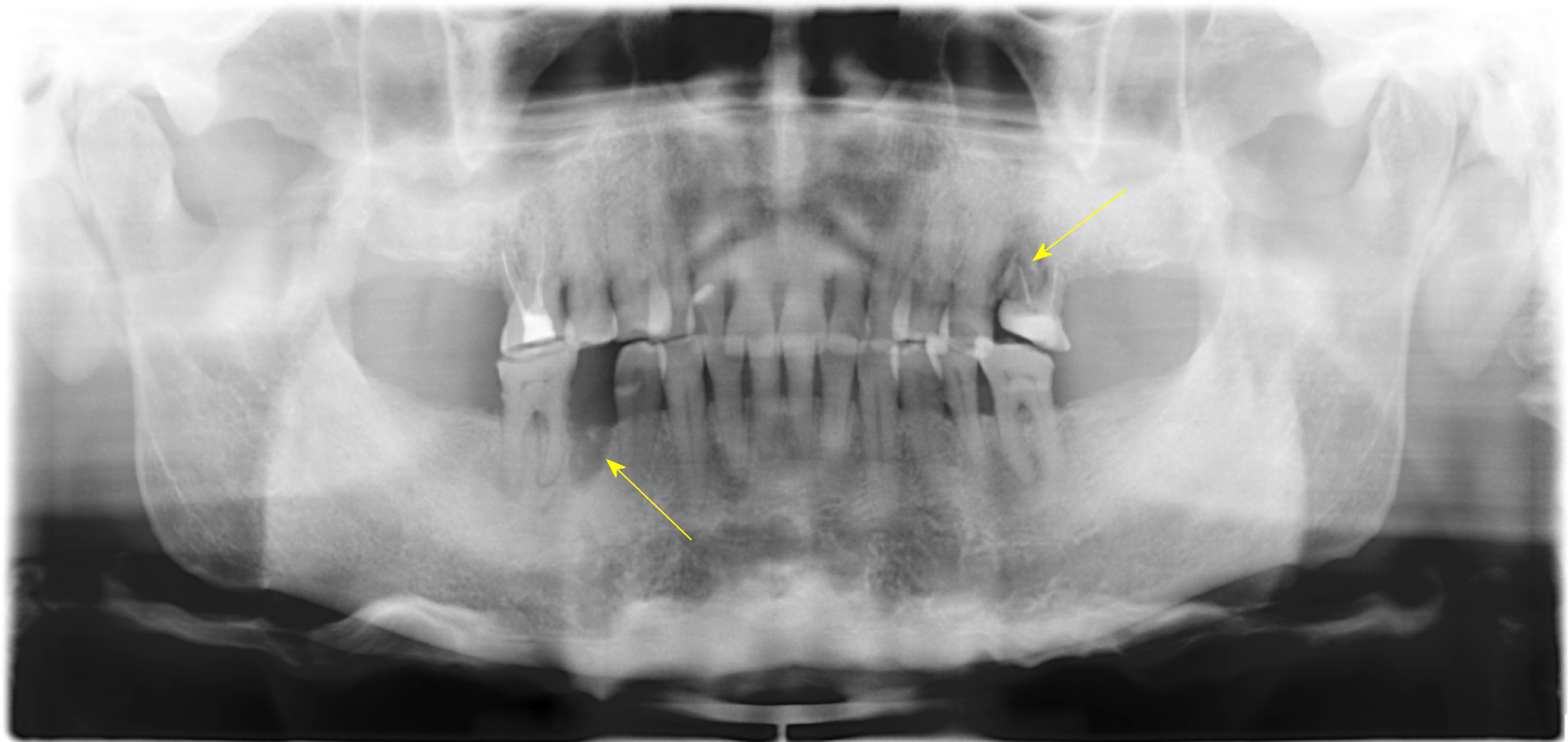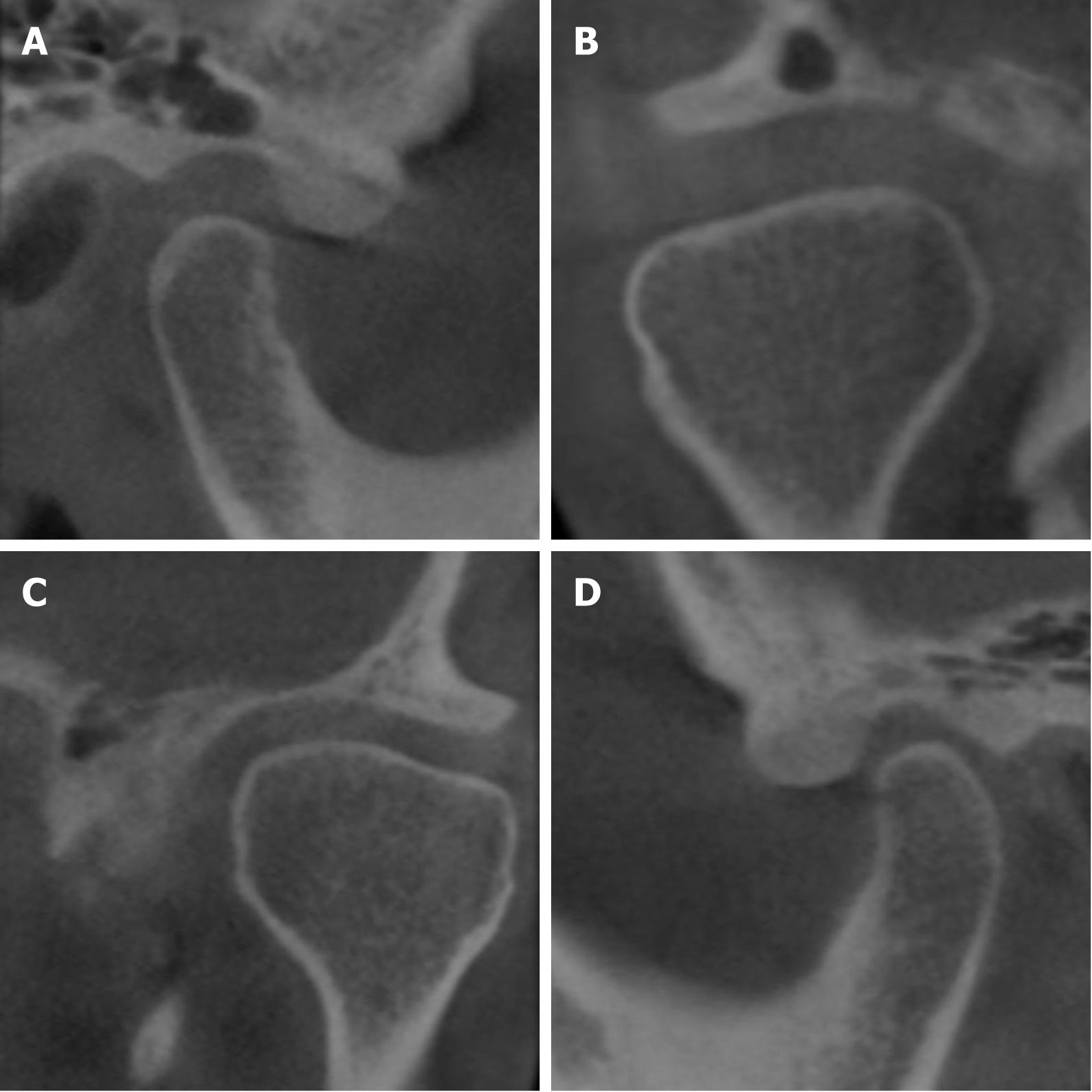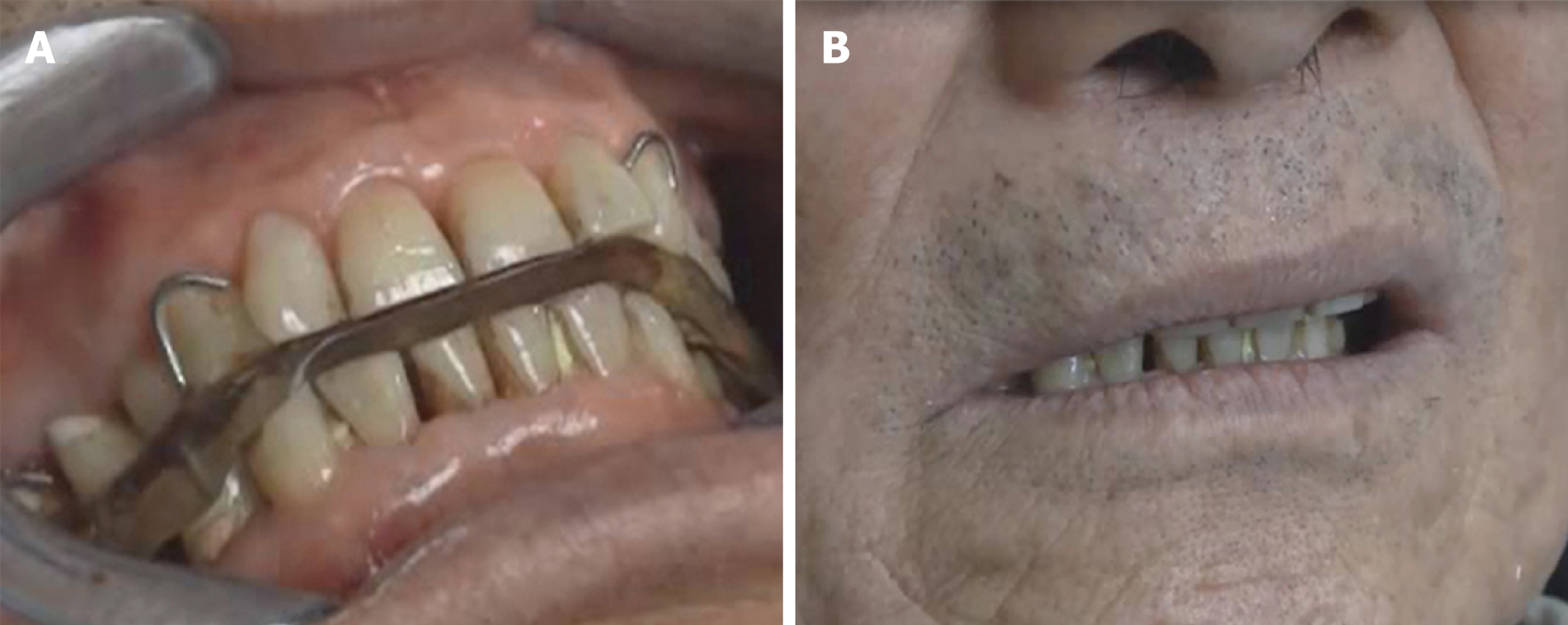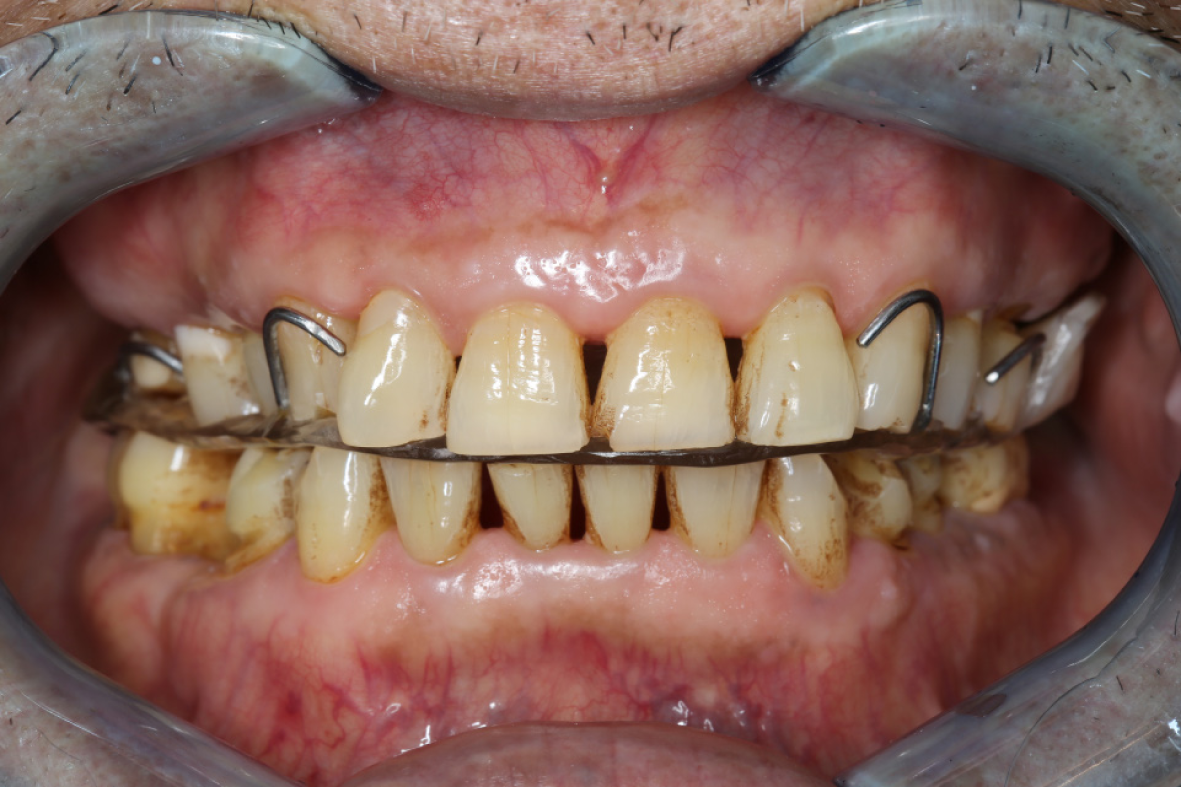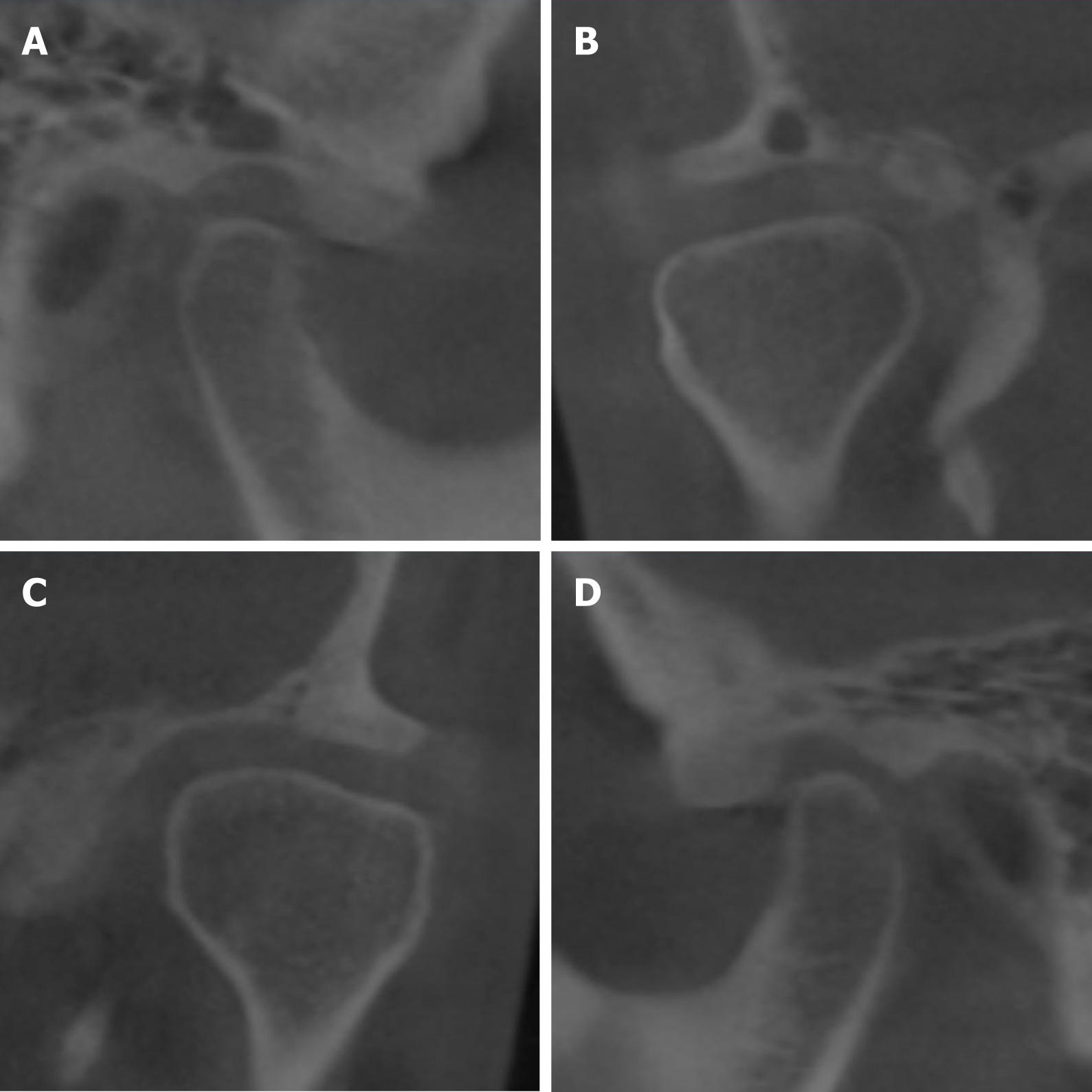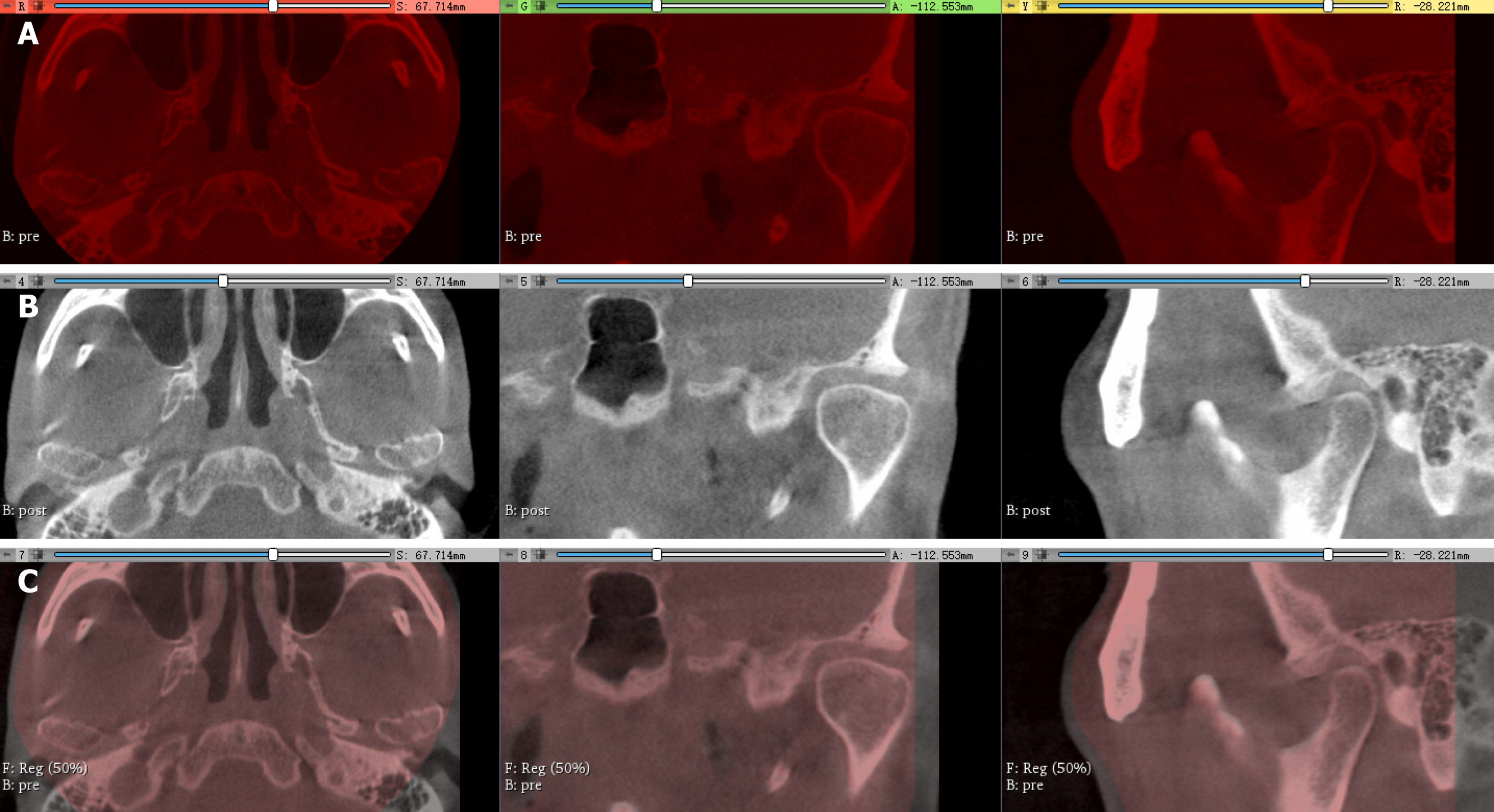Published online Feb 26, 2019. doi: 10.12998/wjcc.v7.i4.516
Peer-review started: November 14, 2018
First decision: December 22, 2018
Revised: January 8, 2019
Accepted: January 26, 2019
Article in press: January 26, 2019
Published online: February 26, 2019
Processing time: 104 Days and 0.7 Hours
Bruxism is a jaw-muscle activity characterized by the clenching or grinding of teeth. It can be divided into nocturnal bruxism and diurnal bruxism (DB). DB secondary to antidepressants is rare and refractory. Reports associated with antidepressant-induced DB are mostly anecdotal without long-term follow-up. The effect of drug intervention on antidepressant-induced DB is still contested. We herein report the first case of successful treatment of venlafaxine-induced DB with an occlusal splint.
This case report describes detailed 7-year follow-up of a patient with venlafaxine-induced DB treated with an occlusal splint. The patient who complained about involuntary daytime tooth grinding after taking venlafaxine for a period of 4 mo and was diagnosed with venlafaxine-induced DB. Subsequently, an occlusal splint with modified bilateral buccal-pterygoid pads was used to treat his tooth grinding and to protect the dental structures from tooth wearing. The patient reported remission of symptoms after several months of treatment. His grinding activity was gradually and stably controlled after 2 years, with an almost complete recovery from DB after 6 years.
The maxillary buccal-pterygoid splint can be used as a noninvasive approach to treat venlafaxine-induced DB.
Core tip: Secondary diurnal bruxism (DB) is rare and refractory. The existing literature associated with antidepressant-induced DB mostly consists of anecdotal reports without long-term follow-up. Therapeutic effects of drug intervention are still unclear. This case is the first to describe successful treatment of venlafaxine-induced DB with an occlusal splint.
- Citation: Chen JM, Yan Y. Long-term follow-up of a patient with venlafaxine-induced diurnal bruxism treated with an occlusal splint: A case report. World J Clin Cases 2019; 7(4): 516-524
- URL: https://www.wjgnet.com/2307-8960/full/v7/i4/516.htm
- DOI: https://dx.doi.org/10.12998/wjcc.v7.i4.516
Bruxism is a jaw-muscle activity characterized by the clenching or grinding of teeth. Its prevalence is reported to be 8% to 20% among the adult population[1]. Bruxism can be divided into nocturnal bruxism and diurnal bruxism (DB) according to the different circadian rhythms. The diurnal form, a kind of parafunction that occurs while awake[2], is always secondary to neurological diseases[3,4] and psychotropic drug use[5-7] as a manifestation of movement disorders in the oromandibular region.
Furthermore, focal movement disorder mainly manifesting as DB has not been well studied by dentists and there exist few reports of successful treatment. In this paper, we report a patient with venlafaxine-induced DB successfully treated with a maxillary buccal-pterygoid splint.
A 69-year-old married man who suffered from “involuntary daytime tooth grinding” for a period of 2 mo presented to the Department of Prosthodontics of the Sun Yat-sen University Hospital of Stomatology.
He reported involuntary tooth grinding and jaw tenderness during the day after taking venlafaxine 150 mg/d, quetiapine 100 mg/d, and lorazepam 2.0 mg/d for 4 mo to treat his major depressive disorder. The bruxism occurred during the daytime and subsided when asleep. And in the 2 mo that followed, the patient’s DB became aggravated and he had his mandibular posterior tooth extracted after a crown fracture. Thus, the patient turned to us for help.
The patient had a history of ischemic stroke decades ago. Antithrombotic agents (clopidogrel/cilostazol) combined with atorvastatin/rosuvastatin and butylphthalide were routinely used to lower the risk of stroke and heart complications. Eight months prior, the patient was admitted to the Psychology Department of the Huifu Xi Branch of Guangdong General Hospital for “insomnia for 20 years and exacerbation in 20 d”. An initial diagnosis of insomnia was made. Routine blood work and biochemical and thyroid function examinations were within the normal range. Head MRI and MRA showed multiple remote ischemic areas at the bilateral frontal lobe and parietal cortex. Sleep monitoring tests indicated no abnormal limb movements or sleep apnea syndrome, but poor sleep quality with an efficiency of only 76.7%. While hospitalized, duloxetine 60 mg/d, lorazepam 2.5 mg/d, and zopiclone 7.5 mg/d were given, but the patient was unable to comply with medication usage instructions. Thus, a combination of physical and psychological therapy was started. After therapy, the patient had improvement in sleep quality and remission of stress and anxiety. A discharge diagnosis of “depressive disorder” was reached and duloxetine 60 mg/d, lorazepam 3.0 mg/d, and quetiapine 100 mg/d were prescribed after the patient left the hospital. Two months later, the patient began to complain about headaches, dizziness, insomnia, feelings of worthlessness, and decreased energy. He was diagnosed with major depressive disorder at the Department of Psychiatry of Guangdong General Hospital. Subsequently, venlafaxine 150 mg/d, lorazepam 2.0 mg/d, and quetiapine 100 mg/d were started for the treatment of depression. After 4 mo of therapy, the patient had a partial remission from depression.
He had no previous personal or familial history of movement disorder.
He seemed to be depressive and numb, but he could answer our questions consciously and clearly. Daytime involuntary tooth grinding occurred while resting, but paused when he spoke. Dental examination showed the following findings: (1) No facial asymmetry; (2) No evoked pain or tenderness was noticed when palpating the bilateral temporomandibular joint (TMJ) regions (the anterior wall of external auditory canal and the region anterior to the tragus); (3) Examination of mandibular movement revealed a normal mandibular opening (maximum opening 35 mm) and closing pattern without pain or noise. Mandibular lateral, protrusive, and retruded movements were also within the normal range; (4) Intensified bilateral temporalis and masseter in resting position; and (5) Further intraoral study indicated no stable intercuspal position due to the involuntary tooth grinding. Multiple molar teeth (#45, #17, #27, #37, and #47) were lost. All of the residual teeth of the patient were dramatically worn down (the palatal cusps of #24 and #25 and buccal cusps of #34 and #35 were missing). Cervical wedge-shaped defects could be found in the buccal side of #25, #34, #35, and #44.
Panoramic radiograph showed a fresh extraction socket in #45 and suspected root fracture in #26 (Figure 1). Cone-beam computed tomography (CBCT) examination of the TMJ indicated no significant change of bone substance, but a change of the right joint space (Figure 2).
An initial clinical diagnosis of venlafaxine-induced DB was reached.
A maxillary buccal-pterygoid splint was recommended to relieve the symptoms and protect the dental structures from tooth wearing. The maxillary buccal-pterygoid splint (Patent No. 201620908577.7)[8] was designed by Dr. Yan Ying based on the grinding feature of non-centric bruxism. It is composed of the occlusal plate and bilateral buccal-pterygoid pads. The buccal-pterygoid pads extending from the distal side of maxillary canine teeth to the mesial side of maxillary second molar teeth cover approximately two-thirds of the buccal side of the mandibular corresponding teeth, leaving a suitable horizontal gap of 1.5 mm. The occlusal plate with convex surface will open the bite 1.5-2.0 mm in the posterior teeth. Constant daytime use of the splint was suggested, with the patient removing it only during mealtimes. The patient then underwent long-term follow-up.
The patient insisted on the same drug recipe and the final stable medication doses were venlafaxine 150 mg/d, quetiapine 100 mg/d, and lorazepam 2.0 mg/d across 7-year follow-up. All of the results of splint therapy and prognosis were recorded in detail and regular occlusal adjustment was performed on the splint when needed. Jaw tenderness improved dramatically 1 mo after therapy, but deep scratch traces could be found on the bilateral buccal-pterygoid pads (mainly the right side), indicating the presence of tooth grinding. The patient felt a decrease in the frequency of the grinding activity in the early morning, but an increase after noon 3 mo after the procedure. When he returned back after a period of 4 mo of therapy, cracks in the bilateral buccal-pterygoid pads and deeper scratch trace could be seen. Thus, a modified maxillary buccal-pterygoid splint with reinforced wire fused into bilateral buccal-pterygoid pads was given to the patient (Figure 3). Interestingly, the patient reported marked improvement in the frequency and amplitude of daytime tooth grinding 7 mo postoperatively. However, newly-found bite scars on the splint suggested the occurrence of clenching when awake. At a return visit after 9 mo, clenching subsided when wearing the splint and gradually recurred after removing it. At 12 mo postoperatively, the patient again complained about a relapse of tooth grinding with scratch traces found mainly on the left buccal-pterygoid pad. At 24 mo postoperatively, the patient presented with a fracture in tooth #26, possibly due to suspected root fracture and long-term weight overloading. At 30 mo postoperatively, scratch traces on the splint fortunately became less and less noticeable and no new bite scar was noticed. Grinding activity was stably controlled when wearing the splint (Figure 4A and Video 1), but gradually recurred after removing the splint (Figure 4B and Video 2). When he returned for a 6-year follow-up visit, there were no scratch traces but sporadic bite scars on the bilateral posterior region of the splint. Therefore, bilateral buccal-pterygoid pads of the splint were removed, leaving the appliance acting as a stabilization splint to relieve the clenching of the teeth (Figure 5). Three months later, the patient had almost completely ceased clenching and grinding his teeth when wearing the splint (Figure 6A and Video 3). When the splint was removed, he just had slight relapse of clenching, but could control it consciously (Figure 6B and Video 4). A 7-year follow-up CBCT (Figure 7) indicated no change when compared with the previous images. Registration of the pre-CBCT and post-CBCT was performed to further verify longitudinal changes of the bilateral TMJ (Figure 8).
There exist few reports of successful treatment of secondary DB, a kind of rare focal movement disorder. Research on the management of antidepressant drug-induced DB mainly focused on drug treatments. Unfortunately, the effect of drug intervention is still not clear. Furthermore, frequently switching from one drug to another may cause side effects[7]. In our study, we used a maxillary buccal-pterygoid splint as a noninvasive approach to treat venlafaxine-induced DB. With the improvement of symptoms, patient compliance correspondingly increased, and he was more willing to wear the splint.
Bilateral buccal-pterygoid pads of the splint to some extent limited the grinding movement when involuntary grinding occurred. The occlusal plate, which opened the bite 1.5-2.0 mm in the posterior teeth, enabled masticatory muscles to adapt to the new mandibular position and gradually established new working memory. In our case, the patient reported marked improvement of the symptoms, but a relapse at 12 mo. A possible reason for the relapse was that masticatory muscles had not yet adapted to the changed mandibular position. A longer period may be required to establish a stable muscle working memory. Hence, at the follow-up of 24 mo postoperatively, daytime grinding was gradually stably controlled, and the patient had almost completely ceased clenching or grinding his teeth by 6 years postoperatively. CBCT examination of the TMJ indicated no change when compared with the former one before treatment, which also implies that long-term use of a maxillary buccal-pterygoid splint might be harmless to the joint. We hypothesize that the maxillary buccal-pterygoid splint blocks the abnormal reflex arc of the grinding movement through the mechanisms of neurophysiological and biofeedback effects on masticatory muscles. It may alter the transmission of neurotransmitters in a corresponding brain region for mandibular movement, causing a decrease in the displacement and lateral force of daytime tooth grinding. However, further research should be performed to verify the exact mechanism of the maxillary buccal-pterygoid splint on venlafaxine-induced DB.
Furthermore, DB can be affected by many factors. It is difficult to diagnose and treat DB due to its complex pathogenesis. Various neurotransmitters have been implicated in DB[9]. Experimental studies have demonstrated that the nigrostriatal and mesocortical pathways are two main, but different, dopaminergic pathways involved in motor control. Dopamine (DA) transmitters are believed to play a central role in the appearance of grinding/biting behavior[10,11]. There is also evidence for the involvement of other neurotransmitters, such as serotonin (5-HT) and norepinephrine, which are closely related to the regulation of DA in the central nervous system (CNS). In our case, the patient did not report bruxism or any other oral movement disorder until 4 mo after he took venlafaxine at a dose of 150 mg/d. Venlafaxine is a selective serotonin and norepinephrine reuptake inhibitor. According to its pharmacology, venlafaxine has a high affinity to 5-HT when the dosage exceeds 150 mg/d[12]. The sequent excess of 5-HT in the synapses leads to an inhibitory effect on the release of DA from the mesocortical tract, thereby leading to bruxism[13].
The patient in our case continued a complicated combination of medications (zopiclone, lorazepam, quetiapine, clopidogrel, cilostazol, atorvastatin, rosuvastatin, and butylphthalide), which made the observation much more confounded. However, none of those medications have been reported to induce DB. Given that there are increasing reports of DB associated with antidepressant drugs (paroxetine[13], sertraline[14], fluvoxamine[15], venlafaxine[16], fluoxetine[17], and atomoxetine[18]), our clinical impression was that the patient's DB was secondary to venlafaxine use. The cause-and-effect relationship is supported by the following observations: (1) The patient exhibited no previous history of bruxism or other movement disorder before taking venlafaxine; (2) Duloxetine 60 mg/d was irregularly taken for 2 mo without occurrence of DB; and (3) DB occurred 4 mo after switching from duloxetine 60 mg/d to venlafaxine 150 mg/d.
Existing reports also indicated that DB can be induced by brain injury through the subsequent disruption of normal interplay of neuronal circuits in different brain areas[19,20]. DB, or other presenting forms of movement disorders, were found from several days to several years after frontal lobe or thalamic injury[21-24]. Chih-Sung Liang[24] explained the mechanism by dendritic plasticity and changing patterns in the synaptic activity of injured brain neurons. In our case, head MRI and MRA performed when the patient was admitted to the Huifu Xi Branch of Guangdong General Hospital indicated no progressive damage. As no additional head MRI or MRA was performed after the DB occurred, we are unable to conclude that his bruxism was associated with his cerebral stroke. Of course, it is possible that his cerebral stroke might contribute as a risk factor, making it more difficult for damaged neurons to recover, and previous brain injury history should be noted when treating refractory DB.
Aiming to regulate the dysfunction of neurotransmitters in CNS, drug interventions have been used to treat antidepressant-induced DB. Nevertheless, it is still contested. According to Fitzgerald et al[7] in a 1995 report, buspirone, a kind of 5-HT receptor agonist, is only effective in only one of the four cases of SSRI-induced DB with a history of psychotropic drugs consumption. Bostwick et al[14] claimed that buspirone was effective in treating sertraline-induced DB. Pavlovic et al[16] found that buspirone was effective in venlafaxine-induced DB. It is also reported that tandospirone can result in remission of paroxetine-induced DB[12]. However, Miyaoka et al[15] reported a failure to relieve fluvoxamine-induced DB using tandospirone. The patient’s own medical history, medication history, and the complicated etiology of secondary DB may be responsible for these conflicting results. In addition, Fitzgerald et al[7] also described a severe relapse of psychic symptoms and drug side effects after drug withdrawal or switching to alternatives. Long-term effects of drug intervention on antidepressant-induced DB are still unknown. To conclude, it is a challenge to find specific antidepressants that can avoid the occurrence of drug-induced DB or other movement disorders and remain effective.
This case may be the first to report the successful treatment of venlafaxine-induced DB with an occlusal splint. Reports associated with antidepressant-induced DB are mostly anecdotal without long-term follow-up. Thus, more research, particularly randomized controlled trials, should be carried out to further study the mechanism and treatment of antidepressant-induced DB.
Attention should be paid to the medical and medication history in patients with bruxism. This case report suggests that the maxillary buccal-pterygoid splint, a noninvasive approach, can be used as the preferred choice when treating drug-induced secondary bruxism before changing the medication regimen.
Manuscript source: Unsolicited manuscript
Specialty type: Medicine, Research and Experimental
Country of origin: China
Peer-review report classification
Grade A (Excellent): A
Grade B (Very good): 0
Grade C (Good): C
Grade D (Fair): 0
Grade E (Poor): 0
P- Reviewer: Teramoto-Matsubara OT, Senol MG S- Editor: Dou Y L- Editor: Wang TQ E- Editor: Tan WW
| 1. | Lavigne GJ, Khoury S, Abe S, Yamaguchi T, Raphael K. Bruxism physiology and pathology: an overview for clinicians. J Oral Rehabil. 2008;35:476-494. [RCA] [PubMed] [DOI] [Full Text] [Cited by in Crossref: 453] [Cited by in RCA: 455] [Article Influence: 28.4] [Reference Citation Analysis (0)] |
| 2. | Lobbezoo F, Ahlberg J, Glaros AG, Kato T, Koyano K, Lavigne GJ, de Leeuw R, Manfredini D, Svensson P, Winocur E. Bruxism defined and graded: an international consensus. J Oral Rehabil. 2013;40:2-4. [RCA] [PubMed] [DOI] [Full Text] [Cited by in Crossref: 578] [Cited by in RCA: 713] [Article Influence: 54.8] [Reference Citation Analysis (0)] |
| 3. | Watts MW, Tan EK, Jankovic J. Bruxism and cranial-cervical dystonia: is there a relationship? Cranio. 1999;17:196-201. [RCA] [PubMed] [DOI] [Full Text] [Cited by in Crossref: 53] [Cited by in RCA: 48] [Article Influence: 1.8] [Reference Citation Analysis (0)] |
| 4. | Kwak YT, Han IW, Lee PH, Yoon JK, Suk SH. Associated conditions and clinical significance of awake bruxism. Geriatr Gerontol Int. 2009;9:382-390. [RCA] [PubMed] [DOI] [Full Text] [Cited by in Crossref: 19] [Cited by in RCA: 23] [Article Influence: 1.5] [Reference Citation Analysis (0)] |
| 5. | Mendhekar DN, Andrade C. Antipsychotic induced bruxism treated with clozapine. J Neuropsychiatry Clin Neurosci. 2009;21:105-106. [RCA] [PubMed] [DOI] [Full Text] [Cited by in Crossref: 10] [Cited by in RCA: 10] [Article Influence: 0.6] [Reference Citation Analysis (0)] |
| 6. | Pekkan G, Kilicoglu A, Algin DI. Treatment of a tardive dyskinesia patient with temporomandibular disorder: a case report. J Orofac Pain. 2010;24:212-216. [PubMed] |
| 7. | Fitzgerald K, Healy D. Dystonias and dyskinesias of the jaw associated with the use of SSRIs. Hum Psychopharm Clin. 1995;10:215-219. [RCA] [DOI] [Full Text] [Cited by in Crossref: 24] [Cited by in RCA: 24] [Article Influence: 0.8] [Reference Citation Analysis (0)] |
| 8. | Yan Ying, Wang JH, Feng YF, Jiang LL, Chen JM, Wu MH; inventor; Guangzhou Sanhuan Patent Agency Inc. assignee. Maxillary buccal-pterygoid splint. Chinese patent CN 201620908577.7. 2017;Apr 10. |
| 9. | Falisi G, Rastelli C, Panti F, Maglione H, Quezada Arcega R. Psychotropic drugs and bruxism. Expert Opin Drug Saf. 2014;13:1319-1326. [RCA] [PubMed] [DOI] [Full Text] [Cited by in Crossref: 46] [Cited by in RCA: 42] [Article Influence: 3.8] [Reference Citation Analysis (0)] |
| 10. | Mascaro MB, Bittencourt JC, Casatti CA, Elias CF. Alternative pathways for catecholamine action in oral motor control. Neurosci Lett. 2005;386:34-39. [RCA] [PubMed] [DOI] [Full Text] [Cited by in Crossref: 19] [Cited by in RCA: 21] [Article Influence: 1.1] [Reference Citation Analysis (0)] |
| 11. | Gómez FM, Ortega JE, Horrillo I, Meana JJ. Relationship between non-functional masticatory activity and central dopamine in stressed rats. J Oral Rehabil. 2010;37:827-833. [RCA] [PubMed] [DOI] [Full Text] [Cited by in Crossref: 15] [Cited by in RCA: 15] [Article Influence: 1.1] [Reference Citation Analysis (0)] |
| 12. | Stahl SM, Grady MM, Moret C, Briley M. SNRIs: their pharmacology, clinical efficacy, and tolerability in comparison with other classes of antidepressants. CNS Spectr. 2005;10:732-747. [RCA] [PubMed] [DOI] [Full Text] [Cited by in Crossref: 310] [Cited by in RCA: 320] [Article Influence: 16.0] [Reference Citation Analysis (0)] |
| 13. | Kishi Y. Paroxetine-induced bruxism effectively treated with tandospirone. J Neuropsychiatry Clin Neurosci. 2007;19:90-91. [RCA] [PubMed] [DOI] [Full Text] [Cited by in Crossref: 23] [Cited by in RCA: 25] [Article Influence: 1.4] [Reference Citation Analysis (0)] |
| 14. | Bostwick JM, Jaffee MS. Buspirone as an antidote to SSRI-induced bruxism in 4 cases. J Clin Psychiatry. 1999;60:857-860. [RCA] [PubMed] [DOI] [Full Text] [Cited by in Crossref: 78] [Cited by in RCA: 60] [Article Influence: 2.3] [Reference Citation Analysis (0)] |
| 15. | Miyaoka T, Yasukawa R, Mihara T, Shimizu Y, Tsubouchi K, Maeda T, Mizuno S, Uegaki J, Inagaki T, Horiguchi J, Tachibana H. Successful electroconvulsive therapy in major depression with fluvoxamine-induced bruxism. J ECT. 2003;19:170-172. [RCA] [PubMed] [DOI] [Full Text] [Cited by in Crossref: 10] [Cited by in RCA: 11] [Article Influence: 0.5] [Reference Citation Analysis (0)] |
| 16. | Pavlovic ZM. Buspirone to improve compliance in venlafaxine-induced movement disorder. Int J Neuropsychopharmacol. 2004;7:523-524. [RCA] [PubMed] [DOI] [Full Text] [Cited by in Crossref: 8] [Cited by in RCA: 8] [Article Influence: 0.4] [Reference Citation Analysis (0)] |
| 17. | Oulis P, Dimitrakopoulos S, Konstantakopoulos G, Tsaltas E, Kollias K. Low-dose aripiprazole in the treatment of SSRI-induced bruxism. J Neuropsychiatry Clin Neurosci. 2012;24:E39. [RCA] [PubMed] [DOI] [Full Text] [Cited by in Crossref: 12] [Cited by in RCA: 18] [Article Influence: 1.5] [Reference Citation Analysis (0)] |
| 18. | Bahali K, Yalcin O, Avci A. Atomoxetine-induced wake-time teeth clenching and sleep bruxism in a child patient. Eur Child Adolesc Psychiatry. 2014;23:1233-1235. [RCA] [PubMed] [DOI] [Full Text] [Cited by in Crossref: 8] [Cited by in RCA: 8] [Article Influence: 0.7] [Reference Citation Analysis (0)] |
| 19. | Chen WH, Lu YC, Lui CC, Liu JS. A proposed mechanism for diurnal/nocturnal bruxism: hypersensitivity of presynaptic dopamine receptors in the frontal lobe. J Clin Neurosci. 2005;12:161-163. [RCA] [PubMed] [DOI] [Full Text] [Cited by in Crossref: 33] [Cited by in RCA: 32] [Article Influence: 1.7] [Reference Citation Analysis (0)] |
| 20. | Suri R, Rodriguez-Porcel F, Donohue K, Jesse E, Lovera L, Dwivedi AK, Espay AJ. Post-stroke Movement Disorders: The Clinical, Neuroanatomic, and Demographic Portrait of 284 Published Cases. J Stroke Cerebrovasc Dis. 2018;27:2388-2397. [RCA] [PubMed] [DOI] [Full Text] [Cited by in Crossref: 34] [Cited by in RCA: 65] [Article Influence: 9.3] [Reference Citation Analysis (0)] |
| 21. | Tan EK, Chan LL, Chang HM. Severe bruxism following basal ganglia infarcts: insights into pathophysiology. J Neurol Sci. 2004;217:229-232. [RCA] [PubMed] [DOI] [Full Text] [Cited by in Crossref: 20] [Cited by in RCA: 17] [Article Influence: 0.8] [Reference Citation Analysis (0)] |
| 22. | Yi HS, Kim HS, Seo MR. Trial of oral metoclopramide on diurnal bruxism of brain injury. Ann Rehabil Med. 2013;37:871-874. [RCA] [PubMed] [DOI] [Full Text] [Full Text (PDF)] [Cited by in Crossref: 9] [Cited by in RCA: 10] [Article Influence: 0.8] [Reference Citation Analysis (0)] |
| 23. | Scott BL, Jankovic J. Delayed-onset progressive movement disorders after static brain lesions. Neurology. 1996;46:68-74. [RCA] [PubMed] [DOI] [Full Text] [Cited by in Crossref: 141] [Cited by in RCA: 122] [Article Influence: 4.2] [Reference Citation Analysis (0)] |
| 24. | Liang CS, Chou MK, Yang FW. Delayed-onset diurnal bruxism, psychic akinesia and depression after carbon monoxide poisoning: a case report. Gen Hosp Psychiatry. 2011;33:82.e9-82.10. [RCA] [PubMed] [DOI] [Full Text] [Cited by in Crossref: 4] [Cited by in RCA: 4] [Article Influence: 0.3] [Reference Citation Analysis (0)] |









